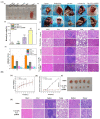Biocompatible Nanocomposites for Postoperative Adhesion: A State-of-the-Art Review
- PMID: 38202459
- PMCID: PMC10780749
- DOI: 10.3390/nano14010004
Biocompatible Nanocomposites for Postoperative Adhesion: A State-of-the-Art Review
Abstract
To reduce and prevent postsurgical adhesions, a variety of scientific approaches have been suggested and applied. This includes the use of advanced therapies like tissue-engineered (TE) biomaterials and scaffolds. Currently, biocompatible antiadhesive constructs play a pivotal role in managing postoperative adhesions and several biopolymer-based products, namely hyaluronic acid (HA) and polyethylene glycol (PEG), are available on the market in different forms (e.g., sprays, hydrogels). TE polymeric constructs are usually associated with critical limitations like poor biocompatibility and mechanical properties. Hence, biocompatible nanocomposites have emerged as an advanced therapy for postoperative adhesion treatment, with hydrogels and electrospun nanofibers among the most utilized antiadhesive nanocomposites for in vitro and in vivo experiments. Recent studies have revealed that nanocomposites can be engineered to generate smart three-dimensional (3D) scaffolds that can respond to different stimuli, such as pH changes. Additionally, nanocomposites can act as multifunctional materials for the prevention of adhesions and bacterial infections, as well as tissue healing acceleration. Still, more research is needed to reveal the clinical potential of nanocomposite constructs and the possible success of nanocomposite-based products in the biomedical market.
Keywords: antiadhesive agents; biocompatible nanocomposites; biopolymers; drug delivery; postoperative adhesion; tissue engineering; tissue healing.
Conflict of interest statement
The authors declare that they have no known competing financial interests or personal relationships that could have appeared to impact this work.
Figures





Similar articles
-
[Preparation and applications of the polymeric micelle/hydrogel nanocomposites as biomaterials].Sheng Wu Yi Xue Gong Cheng Xue Za Zhi. 2021 Jun 25;38(3):609-620. doi: 10.7507/1001-5515.202011024. Sheng Wu Yi Xue Gong Cheng Xue Za Zhi. 2021. PMID: 34180208 Free PMC article. Chinese.
-
Recent trends in the application of widely used natural and synthetic polymer nanocomposites in bone tissue regeneration.Mater Sci Eng C Mater Biol Appl. 2020 May;110:110698. doi: 10.1016/j.msec.2020.110698. Epub 2020 Jan 29. Mater Sci Eng C Mater Biol Appl. 2020. PMID: 32204012 Free PMC article. Review.
-
Incorporation of poly(ethylene glycol) grafted cellulose nanocrystals in poly(lactic acid) electrospun nanocomposite fibers as potential scaffolds for bone tissue engineering.Mater Sci Eng C Mater Biol Appl. 2015 Apr;49:463-471. doi: 10.1016/j.msec.2015.01.024. Epub 2015 Jan 8. Mater Sci Eng C Mater Biol Appl. 2015. PMID: 25686973
-
3D-bioprinted functional and biomimetic hydrogel scaffolds incorporated with nanosilicates to promote bone healing in rat calvarial defect model.Mater Sci Eng C Mater Biol Appl. 2020 Jul;112:110905. doi: 10.1016/j.msec.2020.110905. Epub 2020 Mar 30. Mater Sci Eng C Mater Biol Appl. 2020. PMID: 32409059
-
Green Polymer Nanocomposites for Skin Tissue Engineering.ACS Appl Bio Mater. 2022 May 16;5(5):2107-2121. doi: 10.1021/acsabm.2c00313. Epub 2022 May 3. ACS Appl Bio Mater. 2022. PMID: 35504039 Review.
Cited by
-
The Categorization of Perinatal Derivatives for Orthopedic Applications.Biomedicines. 2024 Jul 11;12(7):1544. doi: 10.3390/biomedicines12071544. Biomedicines. 2024. PMID: 39062117 Free PMC article. Review.
-
Nanotechnology-Based Therapies for Preventing Post-Surgical Adhesions.Pharmaceutics. 2025 Mar 19;17(3):389. doi: 10.3390/pharmaceutics17030389. Pharmaceutics. 2025. PMID: 40143053 Free PMC article. Review.
-
Hydrogels for preventing post-endoscopic submucosal dissection stenosis in early esophageal cancer: a comprehensive literature review.Therap Adv Gastroenterol. 2025 Jun 30;18:17562848251348971. doi: 10.1177/17562848251348971. eCollection 2025. Therap Adv Gastroenterol. 2025. PMID: 40607166 Free PMC article. Review.
References
Publication types
Grants and funding
LinkOut - more resources
Full Text Sources

